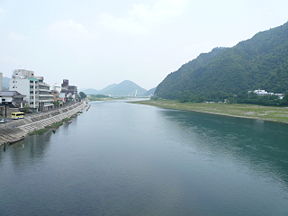
Nagaragawa Onsen
Encyclopedia

Onsen
An is a term for hot springs in the Japanese language, though the term is often used to describe the bathing facilities and inns around the hot springs. As a volcanically active country, Japan has thousands of onsen scattered along its length and breadth...
located along the banks of the Nagara River
Nagara River
The has its source in the city of Gujō, Gifu Prefecture, and its mouth in the city of Kuwana, Mie Prefecture, Japan. Along with the Kiso River and Ibi River, the Nagara River is one of the Kiso Three Rivers of the Nōbi Plain. Previously, the river was named Sunomata River . With a length of , it...
in Gifu
Gifu, Gifu
is a city located in the south-central portion of Gifu Prefecture, Japan, and serves as the prefectural capital. The city has played an important role in Japan's history because of its location in the middle of the country. During the Sengoku period, various warlords, including Oda Nobunaga, used...
, Gifu Prefecture
Gifu Prefecture
is a prefecture located in the Chūbu region of central Japan. Its capital is the city of Gifu.Located in the center of Japan, it has long played an important part as the crossroads of Japan, connecting the east to the west through such routes as the Nakasendō...
, Japan
Japan
Japan is an island nation in East Asia. Located in the Pacific Ocean, it lies to the east of the Sea of Japan, China, North Korea, South Korea and Russia, stretching from the Sea of Okhotsk in the north to the East China Sea and Taiwan in the south...
. The source of the onsen are in the northern part of the city near the Mitabora Shinbutsu Onsen (三田洞神仏温泉). The group was included on the 16th edition of Japan's Top 100 Onsen.
History
There are records of onsens in the area from as far back as 1,300 years, but the current source, Mitabora Shinbutsu Onsen, has only been used since 1968.During the 2004, onsen scandal in which establishments made false statements concerning the source of their water, one ryokan was found to be charging customers for water they claimed was spring water. After the activities were confirmed, restitution was paid.
The water for the Nagaragawa Onsen was starting to become brown and cloudy, the group started looking for new water sources in 1999, which they found within the city limits. In addition to using the new found spring waters for their facilities, they also purchased land to build an onsen stand, at which they would sell the spring waters at retail prices. After complaints that emptying the underground spring would ruin the land and building foundations of the surrounding residents, the project was cancelled.
Surrounding area
The Nagaragawa Onsen are located on the northern side of Mount KinkaMount Kinka (Gifu)
, also known as Kinkazan, is located in the heart of the city of Gifu, Gifu Prefecture, Japan, and rises to a height of . Previously called Mt. Inaba , it has long served as the representative symbol of Gifu. It stands along the Nagara River, creating bountiful nature within the city...
, near Gifu's urban center, so visitors can enjoy both city activities and the relaxing onsen. There are a total of seven hotels and ryokan which draw water from the same source for their onsen:
- Gifu Grand Hotel (岐阜グランドホテル)
- Ushō no Ie Sugiyama (鵜匠の家 杉山)
- Ishikin (石金)
- Gifu Miyako Hotel (岐阜都ホテル)
- Hotel Park (ホテルパーク)
- Kinka (きんか)
- Jūhachirō (十八楼)
During the cormorant fishing
Cormorant Fishing on the Nagara River
has played a vital role in the history of the city of Gifu, Gifu Prefecture, Japan. Throughout its long history, it evolved from a means to live, to a profitable industry, to a major tourist draw...
season from May 11 to October 15, guests can see parts of the fishing tradition from the hotels and ryokan. Though it takes place at night, each cormorant fishing boat has a bonfire (篝火 kagaribi) to light the river surface.
Spring quality
The spring water has high iron content and concentration of carbonic acidCarbonic acid
Carbonic acid is the inorganic compound with the formula H2CO3 . It is also a name sometimes given to solutions of carbon dioxide in water, because such solutions contain small amounts of H2CO3. Carbonic acid forms two kinds of salts, the carbonates and the bicarbonates...
.
- Temperature at source: 15 °C (59 °F)
- pHPHIn chemistry, pH is a measure of the acidity or basicity of an aqueous solution. Pure water is said to be neutral, with a pH close to 7.0 at . Solutions with a pH less than 7 are said to be acidic and solutions with a pH greater than 7 are basic or alkaline...
: 6.7 - Flow: 1000 litres (264 US gal) per minute

